They give truckers full responsibility for loading, hauling and unloading their cattle without ever checking the drivers’ qualifications. The previous norm was for truckers to run cattle up the loading ramp into the truck with an electric prod in one hand and a whip in the other while hollering as loudly as possible.
Hopefully, these situations rarely occur in today’s cow-calf operations, but the producer should make every possible effort to ensure they don’t.
If a truck driver mishandles your cattle, the animals become stressed and product quality is reduced. Stress in cattle can reduce disease immunity, bruise the carcass, cause dark cutters, increase shrink and result in injury to animals and people.
It is important that producers develop a good relationship with their trucking company just as they should with their veterinarian and animal nutritionist.
Before hiring a trucking company, invite the manager to your ranch. Walk him through your loading facilities and explain how animals are supposed to flow through the gates and pens.
Explain why good stockmanship and low-stress handling is important. Outline your expectations of a trucking company and offer a multi-year contract with performance requirements.
The National Beef Quality Assurance Advisory Board initiated a Master Cattle Transporter training program as part of the Beef Quality Assurance effort. The program provides a training manual and a 45-minute video for truckers to use in training. Much of the information in this article is taken from these training aids.
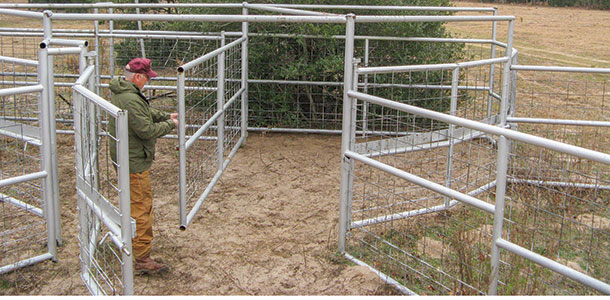
Loading
It is just as important to use good stockmanship practices in loading cattle as it is in moving them between pastures and working them in the pens. Do not approach cattle from directly behind because you will be in their only blind spot. Cattle have a wide area of peripheral vision. Their flight zone is the distance that cattle can be from you and feel comfortable.
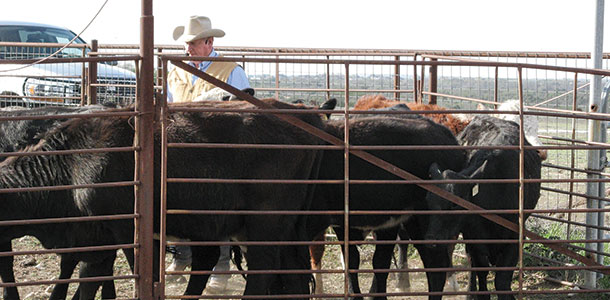
You can use the flight zone to quietly move cattle. There is a place on the shoulder of the animal called the point of balance. You can use this point to encourage the animal to go forward and backward.
“The most important thing to remember is to take it slow when loading cattle and be patient,” says Ted Rousch, Schulenburg, Texas. “My specialty is hauling Longhorn cattle for breeders, and I have to be extremely careful to give the animals time to load without catching their horns in a fence or gate.
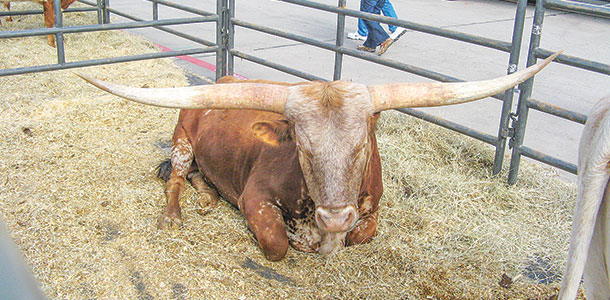
If a horn is broken, the animal loses value very fast. The shipper usually loads the cattle, and that is what I prefer. I stop several times en route and inspect my load to make sure the cattle are all right.”
When the truck arrives at the ranch, inspect it to ensure the trailer is clean. Manure and urine from previous hauls can spread disease and emit odors that smell strange to the animals being loaded.
Unfamiliar odors make cattle hesitant to enter a truck. Look for protruding pieces of metal or other materials that might injure the cattle and ask the driver to inspect your loading facilities for the same. He or she might notice something you missed. Make sure all the cleats are in place and secured on the ramps both in the loading facilities and in the truck.
If a portable loading chute is to be used, make sure it is in good repair and securely tied to the truck. The trailer should be backed up to the loading chute squarely and evenly. There should not be a gap between the trailer bed and loading ramp.
The producer should know the weights of cattle to be shipped, and it is the driver’s responsibility to know the dimensions of the trailer and the recommended maximum weight for each compartment.
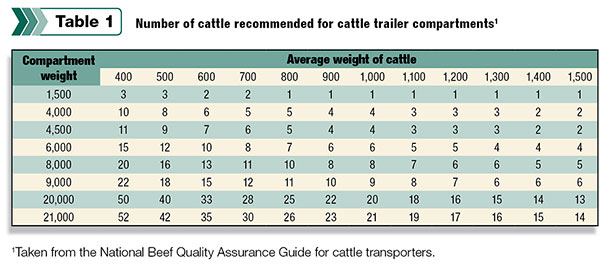
Only load the size of cattle that will safely and humanely fit the trailer. Table 1 can serve as a guide for the number of animals to place in each compartment. The values presented in this table are recommendations only.
“We are very careful not to overcrowd cattle on a truck,” says Jay Gray, general manager of Graham Land and Cattle Company and Sunset Livestock Carriers at Gonzales, Texas. “Normally, our feedlot personnel load cattle at our operation because they are accustomed to handling animals in a slow, easy manner.
We expect our drivers to use good driving habits such as avoiding quick starts, stops and turns. Our trucks are inspected regularly for cleanliness because we do not load a dirty truck. In addition to our own trucks, we hire contract haulers and expect the same performance from their drivers as we do from our own.”
Make sure all cattle to be loaded appear healthy and no foot injuries are noted. Do not load cattle with cancer eyes, debilitated thin animals, downers or animals that appear sick. You do not want to deliver sick or injured animals to your customers.
“We watch cattle as they come down the alley toward the loading chute,” says Gray. “If a calf looks sick or injured, we usually don’t load it. We will load animals with soft feet due to founder if they are going to a processor. They are put on the lower deck at the back of the truck so they don’t have to climb ramps other than the one for loading. This also allows unloading the foundered animal first at their destination.”
Traveling
Producers should plan cattle transportation for periods of favorable weather forecasts. On the day of transport, check the weather to determine if the road is clear and passable. Check with the driver on the route he intends to use. Has he taken into account weather and road construction?
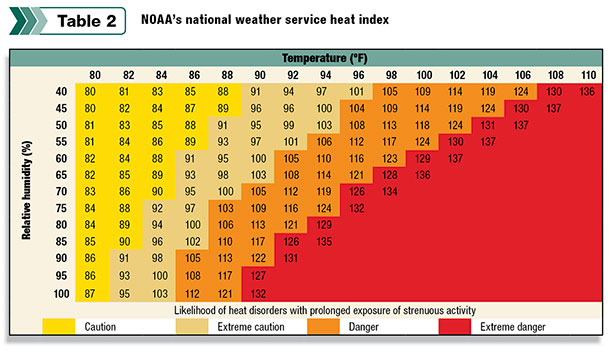
Avoid transporting cattle when the heat is greater than or equal to 100ºF (See Table 2). Try not to haul and handle cattle between 11 a.m. and 4 p.m., which is usually the hottest time of day.
If cattle must be hauled at times of high temperature and humidity, ask the driver to avoid stopping. If he must stop, he should make the duration as short as possible and try stopping during cooler parts of the day. The driver should try to park in shaded areas.
During hot weather, consider placing fewer cattle on the trailer to allow air movement between the animals. Handling cattle gently and patiently is especially critical in extreme heat conditions. When cattle are stressed in extreme heat, they are more likely to become non-ambulatory, sick and even die.
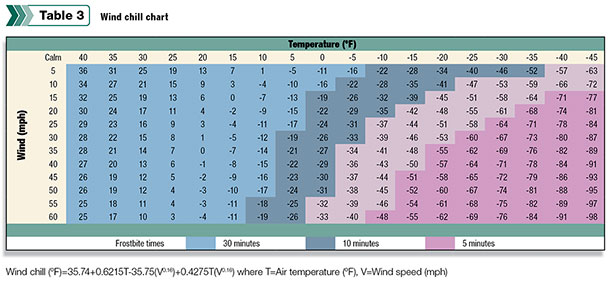
Click here on on the image above to view it at full size in a new window. (PDF,
Extreme wind and cold conditions can also have drastic adverse effects on cattle health. Unprotected cattle hauled at highway speeds can be subjected to dangerous wind chill. If cattle are wet, the danger is even greater. Extreme cold conditions exist when the wind chill is below 0ºF (See Table 3).
If cattle must be transported in cold and windy conditions, stops should be avoided. It is critical to deliver cattle to their destination as quickly as possible.
Before loading the trailer, ensure the driver has all the paperwork needed for transit and unloading. You don’t want cattle standing on the truck while the driver is trying to trace missing paperwork.
After the trailer is loaded, all sides should be checked to make sure the cattle are standing and ready for travel. The driver should pull away from the chute slowly and make gentle turns.
This is especially important the first hour on the road while cattle are getting their balance. Cattle on a long haul should be checked after two hours on the road, and then every four hours after that.
The same care should be taken when cattle are unloaded at their destination as recommended for loading. Work with your livestock hauler to ensure that the animal value you worked to achieve isn’t eroded on the way to market. ![]()
Robert Fears is a freelance writer based in Texas.
PHOTOS
PHOTO 1: Before loading and unloading cattle, check all corral gates to make sure they open and close properly.
PHOTO 2: Cattle need to be moved quietly in the loading process.
PHOTO 3: Extra care must be taken when transporting Texas Longhorns because a broken horn ruins their value. Photo by Robert Fears.








